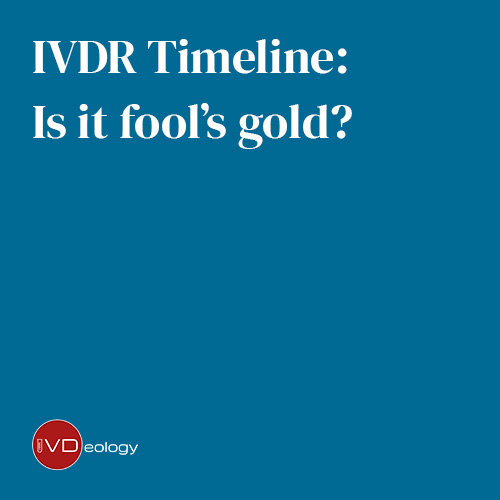
Happy April 1st everyone! It feels we can all take a collective deep breath. We got through lockdown, Brexit came and went (which identified its own problems – but that’s a different blog!) so it feels that we’ve made it! So I celebrate this day by sitting in a sunny spot sipping my freshly brewed coffee, then it hit me – ‘Holy Moley, IVDR is coming!’. For being such an enormous dark shadowy figure looming on the horizon, we lost sight of it in the fog of the events of the last few months. But now the need for preparing for this transition is fully in focus.
We know that (at the time of writing) the IVDR will fully come into force on 26th May 2022. It presents a seismic change in the way IVDs are regulated within the EU. It replaces the aged and slightly creaking IVD Directive with the overall aim to make IVD devices placed on the market safe and effective, but it is a significant uplift on the current regulatory requirements.
Conservative estimates for a transition from the IVDD to the IVDR for manufactures is minimum 12-18 months taking into account the interactions with notified bodies, conformity assessments, technical file sampling, and for class Ds the additional burden of external testing labs and availability of common specifications. The upshot of this is that if you intend to maintain devices on market under the IVDR from May next year, you should be well under way in your transition activities.
From our experience we know there are some common areas that require much focus:
- Intended Purpose statements
- Use and control of economic operators
- Packaging and labelling updates
- Performance evaluation
- Technical file remediation
- Quality Management System updates
Each piece of this jigsaw can take many months to plan, review and implement changes. All this needs to be done before the EU notified body reviews your systems. The resource and time required to do this should not be underestimated so planning and budgeting is essential.
To add further complexity, we are just over a year away from implementation, and we still only have 4 notified bodies designated to the IVDR. While these notified bodies are established and ready to support the industry, it seems to me that this is a very small funnel to put a very large number of devices through to compliance. There will be a time soon where the available notified bodies will not be able to support further customers, either under the IVDD or IVDR framework. The availability of these gate keepers is a real concern and should be keenly watched in the following weeks and months ahead.
We also know that the European Commission is behind on providing the suitable framework for the IVDR to be fully implemented. There are still many unknowns regarding Eudamed and Common Specifications for higher risk devices, just think of the number of Covid-19 devices placed on the market in the last 12 months alone. Without sufficient guidance, strategic planning for transition is more and more challenging.
So where are we going to be in 12 months’ time? Will the IVD industry be ready for the IVDR? This is the million-dollar question. Personally, I think we are far behind where we all thought we would be two years ago. Unless the European Commission considers an extension to the transition process, the industry be facing significant, time critical hurdles. The potential scenario where devices will not be available on the market is a very real risk, and this will have significant implications to the healthcare system.
While there are still many unknowns, and it may be difficult to navigate through the complexities of the IVDR transition, I think it is important to not wait for answers from either the commission or notified bodies. The IVD industry needs to pick a path towards the IVDR and crack on! And don’t pin all your hopes on a delay to the IVDR timeline, as it may never come, and hope is not a strategy!
…. Now, back to my coffee!
